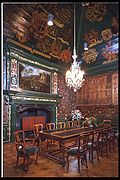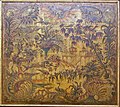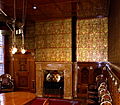History
Cuir de Cordoue originated from North Africa and was introduced to Spain as early as the ninth century. In Spain such embossed leather hangings were known as guadamecí, from the Libyan town of Ghadames, while cordobanes ("cordovan") signified soft goat leather. [2] In 1316, a Cuir de Cordoue guild existed in Barcelona. Spanish gold leather was popular until the early seventeenth century.
In the fifteenth or sixteenth century, the technique reached the Low Countries, first in Flanders and Brabant, where it was further developed. Though there were craftsmen in several cities (such as Antwerp, Brussels, and Ghent), the major handicraft center for gold leather was Mechelen, where it was mentioned as early as 1504. In the Dutch Republic gold leather-making flourished in the seventeenth century in Amsterdam, The Hague and Middelburg. In Amsterdam, at least eleven gold leather-makers were active. One of them, Hans le Maire, because of the smell, the need for water, wind and light, working at the edge of the city [3] or in Vreeland, [4] used up to 16,000 hides of calves and some 170,000 leaves of silver annually. [5]
Dutch Cuir de Cordoue was exported to Germany, Denmark, Sweden, China and Japan. The last Amsterdam gold leather merchant Willem van den Heuvel closed around 1680, but the trade and production continued in Flanders and Northern France.
With the advent of printed wallpaper from about 1650, often imported from China as well as made in Europe, the far more expensive leather wallcoverings began to decline, though they continued to be used, in a rather revivalist sprit, in very luxurious homes.
Embossed wall coverings made to imitate antique embossed leather include Tynecastle, or Modeled Canvas. It was developed and patented in 1874 by designer W. Scott Morton (1840–1903). It was made by hand pressing canvas into carved wooden molds and dry it. It was colored after it was stuck to the wall. [6]
Japanese Leather Paper imitates embossed leather. It is crafted from sheets of handmade paper pressed together. It is then embossed and gilded with the field color stenciled on it. A coat of lacquer was added to protect it and create a sheen. [6]
During the colonial period in the United States, embossed leather panels were occasionally used as an accent, as a dado, on a screen, or above a chimney. [7] In the last quarter of the 19th century, leather panels were revived and used in select rooms of mansions such as libraries. Introduced in the 1860s as "oil leather papers", the coverings later became known as "leather paper" and were offered in catalogs from Paul Balin in Paris' Birge in Buffalo, New York; and Jeffrey & Co. and Woollams & Co. They included embossing, gild and painted finishes designed to imitate leather wallpaper and were used to line furniture and cabinets. Their use continued in fancy homes of the late 19th and early 20th century decorating [7] Lincrusta and Anaglypta were competing products. Leather papers were often made up of a series of paper laminates which were forced into shape with a mold, while Lincrusta is a patented composite material, and Anaglypta is a simthat were not designed to look like leather wallpaper. Rottman, Strome & Co. became a major producer based in England with manufacturing in Japan. Lutson Goudleder made the imitation leather coverings in southern France and they were also made in Poland. [7]
Technique
Cuir de Cordoba was usually made of fine leather; often calf skins were used. The technique consisted of shaping panels of wet leather over wooden moulds, then painting them, then oil-gilding and lacquering them. Sometimes smooth panels of painted Cuir de Cordoue were used.
Patterns for these panels followed fashions in silk damask, at some lag in time, since the high-relief wooden moulds were laborious to make. After the second half of the 18th century, this luxurious artisan product was no longer made, [8] its place taken in part by chintz hangings and printed wallpapers. In the eighteenth century Chinoiserie patterns were popular with Cuir de Cordoue.
This page is based on this
Wikipedia article Text is available under the
CC BY-SA 4.0 license; additional terms may apply.
Images, videos and audio are available under their respective licenses.









